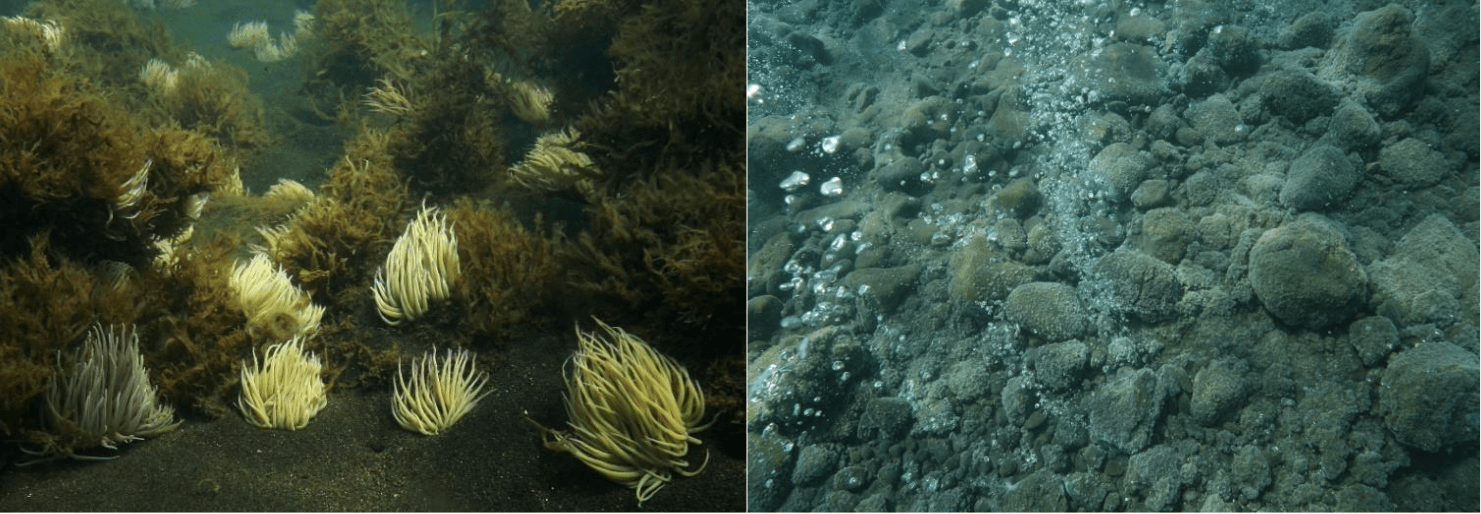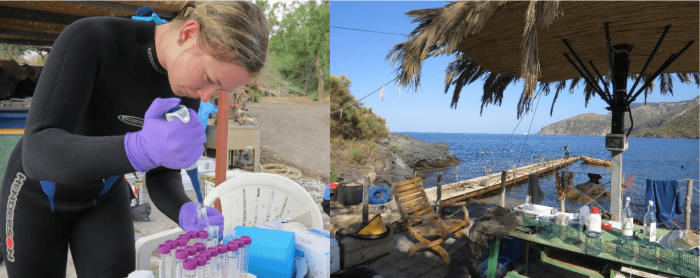
Anemones are abundant in an acidified ocean. But are they thriving? New genomics research shows that ocean acidification puts these animals under considerable stress. The good news is that some marine animals can tolerate the impacts of increased carbon dioxide levels in seawater.
Ocean acidification (OA) is a threat to marine life. Thanks to the discovery of marine carbon dioxide (CO2) seeps, we are able to observe the long-term effects of acidification on marine life. These seeps are natural laboratories and a window into the future.
Our study focused on natural CO2 seeps off Volcano Island in Sicily, Italy, which are very well described in regards to various geochemical measurements. This shallow coastal vent site with 1-3 meters in depth runs parallel with the coast. Here, a natural flux of CO2 gas from underwater volcanic vents acidifies surrounding seawater from average pH 8.2 down to pH 7.6, where effects of long-term increases in CO2 levels can be observed in situ. As CO2 levels increase, marine biodiversity decreases. But what about the effects on survivors?
To investigate the effects of climate change on these marine organisms at the molecular level, we studied the soft-bodied sea anemone Anemonia viridis that is abundant at these CO2 seeps. This temperate sea anemone is symbiotic, similar to many corals that are their close relatives, having an endosymbiotic algae in their tissues that provides them with essential nutrients. Compared to corals with hard skeletons that under OA conditions usually lose their symbiont and die, termed “coral bleaching,” the sea anemones seem to be thriving at these CO2 seeps. Several physiological measurements of this symbiotic sea anemone previously performed at this site confirmed no impact on density or type of the symbiont along the CO2 gradient.

Processing of the samples at the local “laboratory” at Volcano Island, Sicily – Italy. (Photo credit: Jason M. Hall-Spencer)
In this study, we have used advanced “deep sequencing methods” and have shown that high CO2 represents stressful conditions for the sea anemones, whereas the symbiont was less affected. Several genes related to cellular stress and so-called “jumping genes” were highly activated in the sea anemone at high CO2 level compared to the normal seawater conditions. Despite these internal conditions, the sea anemones had no obvious external signs of stress.
Although studying marine organisms in situ complements various laboratory experiments, CO2 seeps are invaluable for studying species in the whole ecosystem. Despite the internal cellular stress, it seems soft-bodied marine animals are able to cope with acidification far better than organisms with hard shells or skeletons such as reef-forming corals. Further research into the precise molecular mechanisms that are underlying this resilience is still needed to be able to foresee the response of other marine organisms to the future climate changes.
This work has been carried out at The Arctic University of Norway, in collaboration with the North University of Bodø and research groups in Canberra (Australia), Plymouth (England), Palermo (Italy) and Tsukuba (Japan).
This research adds to the large body of scientific articles published from this CO2 seep and from other natural OA sites.
These findings are described in the article entitled Ocean acidification at a coastal CO2 vent induces expression of stress-related transcripts and transposable elements in the sea anemone Anemonia viridis, recently published in the journal PLOS One.









